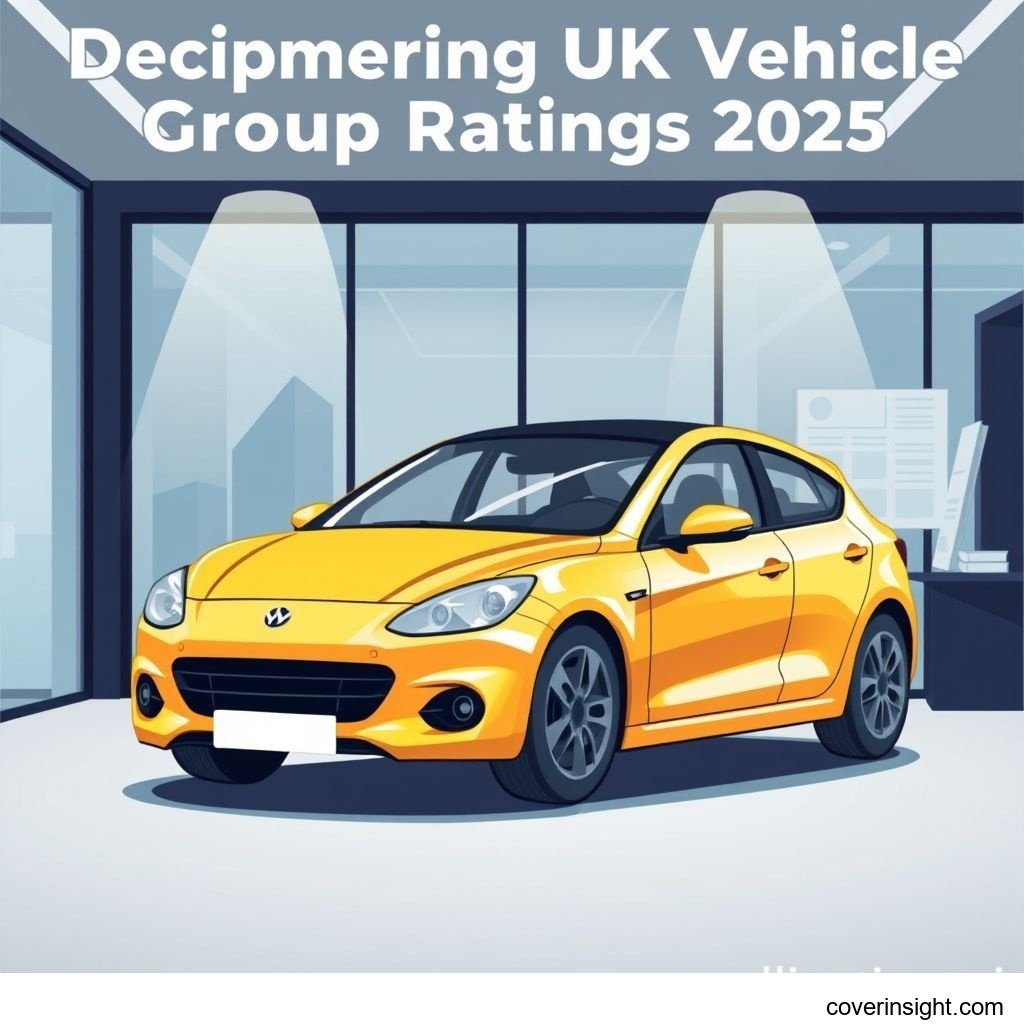Introduction
Navigating the landscape of high-risk car insurance in the UK for 2025 presents unique challenges and considerations. With the ongoing evolution of regulatory frameworks and market dynamics, understanding your options is more crucial than ever. For drivers in Great Britain, particularly, the nuances of Brexit coverage comparisons continue to shape policy offerings and pricing. This guide aims to demystify high-risk insurance, providing actionable insights for making smart choices in the coming year, ensuring you secure adequate protection while managing costs effectively.
Coverage Details
Understanding what your high-risk car insurance policy includes, and equally important, what it excludes, is fundamental. For many, high-risk status stems from factors like a history of claims, driving convictions, or owning a high-performance vehicle. The specifics of your coverage, especially concerning cross-border travel post-Brexit, warrant careful attention to facilitate effective Brexit coverage comparisons.
What’s Included
High-risk car insurance typically covers the same core elements as standard policies, albeit at a higher premium. These generally include:
-
Third-Party Liability: Mandatory by law, this covers damage or injury you cause to other people or their property.
-
Fire and Theft: Protects your vehicle if it's damaged by fire or stolen.
-
Accidental Damage: Comprehensive policies also cover damage to your own vehicle in an accident, regardless of fault.
-
Personal Accident Cover: Compensation for death or serious injury to the policyholder or named drivers.
-
Breakdown Assistance: Often offered as an optional add-on, providing roadside recovery services.
-
Legal Expenses Cover: Helps with legal costs if you need to pursue or defend a claim.
For those planning to drive in Europe, ensuring your policy provides adequate Brexit coverage comparisons for travel is vital. Most UK policies offer minimum third-party cover for driving in EU countries, but comprehensive protection usually requires an upgrade or a separate policy.
Common Exclusions
Awareness of common exclusions is critical to avoid unexpected financial burdens. Typical exclusions for high-risk policies may include:
-
Driving without a Valid Licence: If your licence is expired, revoked, or invalid for any reason.
-
Unauthorised Drivers: Anyone not named on the policy driving the vehicle.
-
Deliberate Damage: Intentional damage to your vehicle.
-
Use for Uninsured Purposes: For example, using a private car for taxi services without specific "hire and reward" cover.
-
Lack of Maintenance: Accidents caused by preventable issues like worn tyres or faulty brakes.
-
Racing or Track Days: Most standard policies exclude damage incurred during competitive driving events.
-
Consequences of Drink/Drug Driving: Incidents occurring while under the influence.
-
Certain Modifications: Undisclosed or unapproved vehicle modifications can invalidate claims.
Always read your policy documents carefully, especially when conducting Brexit coverage comparisons, to understand any limitations related to travel outside the UK.
Cost Analysis
The cost of high-risk car insurance can be significantly higher than standard policies. Several factors influence premiums, and understanding these can help you identify areas where savings might be possible. This section delves into the key price drivers and offers practical tips for reducing your outgoings.
Price Factors
Insurers assess risk based on a multitude of data points. For high-risk drivers, these factors are scrutinised even more closely:
-
Driving History: A record of previous claims, traffic convictions (e.g., speeding, careless driving), or licence points will significantly increase premiums.
-
Vehicle Type: High-performance cars, luxury vehicles, or those with high
insurance group ratings UKare more expensive to insure due to higher repair costs and theft risk. -
Age and Experience: Younger drivers, or those new to driving, typically face higher costs.
-
Location: Postcodes with higher rates of accidents, theft, or vandalism lead to increased premiums.
-
Annual Mileage: Driving more miles generally means a higher risk of an accident.
-
Occupation: Certain professions are statistically considered higher or lower risk.
-
Security Measures: The presence of alarms, immobilisers, and secure overnight parking can reduce costs.
-
Excess Amount: Choosing a higher voluntary excess can reduce your premium.
-
Payment Method: Paying annually is often cheaper than monthly instalments.
Consider how these factors might interact, particularly when reviewing Brexit coverage comparisons, as they can impact cross-border validity.
Saving Tips
Despite the higher costs associated with high-risk insurance, several strategies can help you secure more affordable cover:
-
Increase Your Voluntary Excess: Be prepared to pay more yourself in the event of a claim.
-
Improve Vehicle Security: Install approved alarms, immobilisers, or use a steering wheel lock.
-
Consider a Telematics Policy (Black Box): For younger or improving drivers, this can prove responsible driving habits and lead to lower premiums.
-
Drive Fewer Miles: If possible, reduce your annual mileage.
-
Pay Annually: Avoid interest charges associated with monthly payments.
-
Maintain a Clean Driving Record: Over time, a period of incident-free driving will lead to lower premiums.
-
Take Advanced Driving Courses: Courses like Pass Plus or those offered by the Institute of Advanced Motorists can demonstrate commitment to safe driving.
-
Shop Around: Use comparison websites and direct insurers to get multiple quotes.
-
Adjust Your Vehicle: Downgrading to a car with lower
insurance group ratings UKcan significantly cut costs.
Navigating High-Risk Factors and Brexit Coverage Comparisons
The UK's departure from the European Union has added layers of complexity to insurance, particularly for those with high-risk profiles. When considering your options, it's vital to assess how your individual risk factors interact with the post-Brexit landscape, especially concerning Brexit coverage comparisons.
Understanding Insurance Group Ratings UK
Every car model is assigned an insurance group rating UK from 1 (cheapest to insure) to 50 (most expensive). These ratings are determined by the Group Rating Panel, administered by Thatcham Research, based on factors such as:
-
New Car Price: More expensive cars generally cost more to insure.
-
Parts Cost and Repair Times: Vehicles that are expensive or slow to repair will be in higher groups.
-
Performance: Higher top speeds and faster acceleration can lead to higher groups.
-
Safety and Security Features: Better security and safety can lower a car's group rating.
For high-risk drivers, selecting a car in a lower insurance group rating UK is one of the most effective ways to mitigate the already elevated premium costs.
The Impact of Driver Demographics
Your personal details play a significant role in risk assessment. Insurers analyse vast amounts of data to predict claims likelihood based on:
-
Age and Driving Experience: Young and newly qualified drivers statistically have more accidents.
-
Occupation: Certain jobs are associated with higher or lower risk, either due to the nature of the work or average mileage.
-
Postcode: Areas with higher crime rates or traffic density can increase premiums.
These demographic factors are compounded for high-risk individuals, meaning even slight changes in these areas can affect your ability to get competitive Brexit coverage comparisons.
Vehicle Modifications and Performance
While modifying your car might seem appealing, it often elevates your insurance premium. Insurers classify modifications based on their impact on performance, value, or theft risk:
-
Performance Enhancements: Engine tuning, suspension upgrades, or custom exhausts can significantly increase risk and cost.
-
Cosmetic Changes: Body kits, custom paint jobs, or alloy wheels can increase the car's value and appeal to thieves.
-
Security Upgrades: Approved alarms or tracking devices can, however, lower premiums.
Always declare all modifications to your insurer, as failure to do so could invalidate your policy, a crucial point when looking at Brexit coverage comparisons for vehicle travel.
Choosing the Right Insurer and Financial Stability
Selecting an insurer isn't just about finding the cheapest premium. For high-risk car insurance, ensuring your provider is reliable and financially stable is paramount, particularly in a dynamic environment shaped by Brexit coverage comparisons.
Assessing Insurer Financial Ratings
An insurer financial rating provides an independent assessment of an insurance company's ability to meet its financial obligations, including paying claims. These ratings are issued by agencies like Standard & Poor's, Moody's, and Fitch. Key reasons to check these ratings include:
-
Claim Payout Security: A strong rating indicates the insurer has sufficient capital to pay out large claims, even in adverse economic conditions.
-
Long-Term Reliability: Essential for long-term peace of mind, especially if you anticipate needing to make a claim in the future.
-
Market Stability: A well-rated insurer is generally more stable and less likely to face financial distress.
Always consider the insurer financial ratings before committing to a policy, especially when navigating the complexities of high-risk policies and potential Brexit coverage comparisons.
Customer Service and Claims Handling
Beyond cost and financial stability, the quality of an insurer's customer service and claims handling process is critical:
-
Accessibility: How easy is it to contact them? Are there 24/7 helplines?
-
Efficiency: How quickly do they process claims? What is their average response time?
-
Reputation: Check independent reviews and customer feedback on their claims experience.
-
Support: Do they offer clear guidance throughout the claims process?
A responsive and efficient claims service can significantly reduce stress if you need to make a claim.
Utilising Online Comparison Tools
Online comparison websites are invaluable for high-risk drivers. They allow you to:
-
Compare Multiple Quotes: Quickly get prices from a wide range of insurers and brokers.
-
Identify Niche Providers: Many comparison sites include specialist insurers who cater specifically to high-risk drivers.
-
Filter by Features: Easily compare policy details, excesses, and add-ons.
-
Save Time: Avoid the tedious process of getting individual quotes.
While comparison sites are a great starting point, always visit the insurer's direct website and read the full policy documents before purchasing. For detailed information on regulations and consumer rights, consider consulting resources like the Financial Conduct Authority.
Regulatory Landscape and Brexit Coverage Comparisons
The regulatory environment for car insurance in the UK is robust, designed to protect consumers. For 2025, understanding how these regulations interact with post-Brexit considerations is important, particularly concerning cross-border implications for Brexit coverage comparisons.
Role of the Financial Conduct Authority
The Financial Conduct Authority (FCA) is the regulatory body for financial services firms and financial markets in the UK. Their role includes:
-
Consumer Protection: Ensuring firms act in the best interests of their customers.
-
Market Integrity: Promoting fair and effective competition.
-
Prudential Regulation: Overseeing the financial health of smaller firms.
The FCA's oversight ensures that insurance products are sold fairly and that firms remain solvent. This provides an essential safety net for high-risk drivers.
Association of British Insurers' Guidelines
The Association of British Insurers (ABI) is the voice of the UK's insurance and long-term savings industry. While not a regulator, the ABI sets voluntary codes of conduct and provides guidance on best practices for its members. Their work includes:
-
Developing Industry Standards: Promoting good practice across the industry.
-
Policy Research: Providing data and insights on insurance trends.
-
Consumer Information: Publishing guides to help consumers understand insurance products.
The ABI plays a crucial role in shaping industry responses to evolving challenges, including those stemming from Brexit coverage comparisons.
Future Trends in Brexit Coverage Comparisons
Looking ahead to 2025, the landscape for Brexit coverage comparisons continues to evolve. While the 'Green Card' requirement has largely been removed for UK drivers traveling to the EU, complexities remain:
-
Duration of Cover: Standard policies may only offer a limited period of comprehensive cover abroad.
-
Vehicle Recovery: Repatriation of a damaged vehicle from the EU might not be fully covered.
-
Local Laws: Drivers must still adhere to local driving laws and requirements in each country visited.
-
Pricing Volatility: The economic implications of Brexit could lead to ongoing premium adjustments.
For comprehensive information on all aspects of car insurance, including travel and cross-border specifics, general insurance resources like Insurance Resources Global, and UK-specific information at GB Insurance Home can be helpful.
FAQs
How much does Brexit coverage comparisons cost?
The cost of insurance, even with Brexit coverage comparisons in mind, varies widely based on numerous factors, including your driving history, vehicle type, and where you live. For high-risk drivers, premiums can range from hundreds to several thousands of pounds annually. Specific additional costs for EU travel depend on the insurer and the level of cover required beyond third-party.
What affects premiums?
Premiums are influenced by your driving history (claims, convictions), age, vehicle's insurance group rating UK, postcode, annual mileage, and chosen excess. For high-risk drivers, these factors are amplified, leading to higher quotes.
Is it mandatory?
Yes, it is mandatory to have at least third-party car insurance to drive any vehicle on UK roads. This legal requirement extends to driving abroad, where you must meet the minimum insurance requirements of the country you are visiting.
How to choose?
To choose the best high-risk car insurance, start by using comparison sites, but also get quotes directly from specialist insurers. Focus not just on price, but also on the insurer's insurer financial ratings, customer service, claims handling reputation, and specific inclusions like breakdown cover or extended Brexit coverage comparisons for travel.
Consequences of no coverage?
Driving without valid car insurance in the UK is illegal and carries severe penalties, including a fine of £300 and 6 penalty points, or even an unlimited fine and disqualification from driving if the case goes to court. Your vehicle could also be seized and crushed. It's simply not worth the risk.








Comments